Results 1 to 3 of 3
Thread Information
Users Browsing this Thread
There are currently 1 users browsing this thread. (0 members and 1 guests)
-
11-19-2019, 05:00 PM #1
Growing numbers of families crossing the border are coming from India
Growing numbers of families crossing the border are coming from India and other continents
Sikh family arrives at Iglesia Cristiana El Buen Pastor Church in Mesa
ICE continues to release migrant families seeking asylum in the U.S. after crossing the border illegally, but the numbers are much smaller than last spring, and countries where they are from also have changed.
Daniel Gonzalez, Arizona RepublicPublished 8:00 a.m. MT Nov. 19, 2019 | Updated 8:58 a.m. MT Nov. 19, 2019
One Russian-speaking family arrived at a migrant shelter in Phoenix carrying Louis Vuitton luggage.
They had toted the designer bags across the U.S.-Mexico border after traveling halfway around the globe to ask for asylum in the United States
Another large migrant family from India asked if there was a vegetarian restaurant nearby after being dropped off by federal immigration authorities at the same shelter. They then ordered 15 meatless burgers and sodas to go.
One Russian-speaking family persuaded a volunteer to sell them their van so they could drive themselves across the country to Philadelphia rather than take a Greyhound bus.
Still another Russian-speaking family carried enough U.S. cash to buy four plane tickets totaling $1,300 to fly to the East Coast.
These are examples of some of the non-Spanish speaking migrant families federal immigration authorities have been dropping off lately at local churches after the families arrived at the southern border without documents and asked for asylum to remain in the U.S.
Some of the non-Spanish speaking arrivals have raised eyebrows among local pastors whose churches have been assisting migrant families released by Immigration and Customs Enforcement.
Not only are the non-Spanish speaking families from countries far from the United States, they carry their own cash and credit cards and appear much better educated than the mostly poor Central American families that federal immigration authorities had been dropping off earlier this year.
The sudden arrival of affluent migrant families from outside Latin America even prompted one local pastor to close the church's doors to any more families.
"There are different people coming and the main reason we stopped is because they don't seem to need our help," said Angel Campos, head pastor at Iglesia Monte Vista, a Hispanic church on the east side of Phoenix.
The church had provided assistance to more than 5,000 people until it stopped, Campos estimated.
Previously, most came from Central America, principally Guatemala but also El Salvador and Honduras, three countries known as the Northern Triangle, plagued by high rates of poverty, corruption and violence.
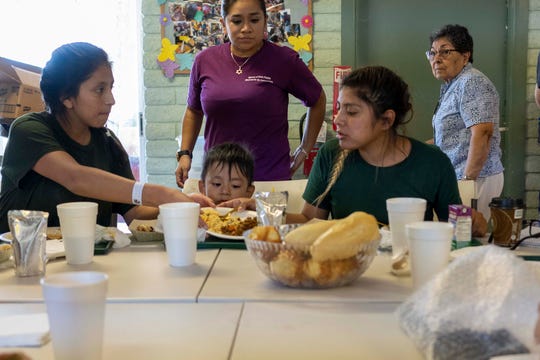
Volunteer members help asylum seekers Sandra Estefania Lema Guaraca, 20, from Ecuador (left), her 3-year-old son Derick Joshua Morocho Lema and Brenda Carolina Rosales, 28, from Guatemala after they were released by ICE at Iglesia Cristiana El Buen Pastor Church in Mesa, Arizona. (Photo: Nick Oza/The Republic)
The Central American families were content to sleep on floors waiting for relatives already in the U.S. to scrape together enough money to buy them bus tickets or plane fares. Many had little more than a sixth grade education, Campos said.
Because they often carried little or no money of their own, the Spanish-speaking families often relied on volunteers at the churches to provide them with food, used clothing and basic necessities like toothbrushes and diapers, he said.
In contrast, the non-Spanish-speaking families coming from India, the former Soviet Union and other countries typically hop on planes within a few hours of being dropped off at the shelters by ICE authorities.
"We love the immigrants. I donít care if they are from Central America or from China," Campos said.
"But the point is we donít see the need for us to (remain) open. ... Some people were even trying to buy a car, or they can take an Uber to whatever place they want," Campos said. "... So that made us see that our participation in helping the people was not so necessary because It was not a crisis anymore."
Local pastors from Hispanic churches who have been helping migrant families since October 2018 say ICE continues to drop off families.
But the numbers have slowed to a trickle after President Donald Trump's administration effectively shut down the wave of families migrating to the U.S. from Central America.
The relatively few families ICE is releasing are from regions in Mexico plagued by drug cartel violence, or from countries in other parts of Latin America struggling with political and economic turmoil, notably Brazil, Cuba, and Venezuela.
ICE has been increasingly releasing non-Spanish speaking migrant families from faraway countries, most notably from India, China and the former Soviet Union. They were released after arriving at the border without documents after traveling from the opposite side of the globe, possibly with the help of international smuggling rings.
In October, Mexico deported 311 migrants from India back to their country after they were caught in Mexico without documents. The Indian migrants had paid smugglers about $41,000 each to reach the U.S., The Times of India reported.
How many migrant families are coming from India, Russia or China?

Volunteer members help asylum seekers Zhu Yanying, 41, and her son Ling Jie Zoel, 17, from China. They were released by ICE at Iglesia Cristiana El Buen Pastor Church in Mesa, Arizona. (Photo: Nick Oza/The Republic)
The sudden arrival of non-Spanish speaking families reflects a big spike in migrant families overall.
The Trump administration has focused almost all of its attention on addressing the huge wave of migrant families coming to the U.S. from Central America, so little attention has been paid to the rise in non-Spanish-speaking migrant families from continents on the other side of the globe.
Border Patrol apprehensions of migrant "family units" hit 473,682 in fiscal year 2019, up 342% from the 107,212 the previous year.
Migrant families from the Northern Triangle and Mexico made up 92% of the total.
The remaining 37,132 from countries outside the Northern Triangle or Mexico was 25 times larger than the 1,442 family unit apprehensions from other countries the previous year, the data shows.
The Border Patrol does not publish data on migrant family apprehensions by citizenship. That makes it difficult to tell how many of those are from other countries in Latin America and how many come from other continents, which the Border Patrol refers to as "extra-continentals."
In the past, most "extra-continentals" apprehended by the Border Patrol were young adult men. Now more "extra-continental" migrants are arriving as families, based on overall Border Patrol data and anecdotal evidence.
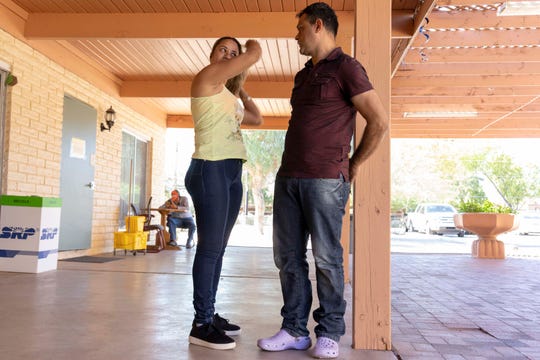 Asylum seekers from Brazil Adriano Moraes da Silva, 43, and his wife Claudineia Ferreira Rodrigues Moraes, 40, talk about their journey after they were released by ICE at Iglesia Cristiana El Buen Pastor Church in Mesa, Arizona. (Photo: Nick Oza/The Republic)
Asylum seekers from Brazil Adriano Moraes da Silva, 43, and his wife Claudineia Ferreira Rodrigues Moraes, 40, talk about their journey after they were released by ICE at Iglesia Cristiana El Buen Pastor Church in Mesa, Arizona. (Photo: Nick Oza/The Republic)
Since July 27, when a vacant elementary school in Phoenix converted into a shelter for migrant families opened, ICE has dropped off 201 families, according to data provided by the International Rescue Committee, which runs the shelter, along with other organizations.
Of the 201, 125 families were from Mexico, and 42 came from countries in the Northern Triangle. An additional 16 families were from other parts of Latin America. Eighteen came from countries outside of Latin America, including 12 families from India, 3 from Romania, two from Kyrgyzstan and one from Azerbaijan.
"Weíve seen families from around the world," said Stanford Prescott, a spokesman for the International Rescue Committee in Arizona.
In trying to stop the wave, the Trump administration has accused migrant families of exploiting "loopholes" in the immigration system to get into the U.S. to seek better economic opportunities not to flee persecution.
Under legal rulings and immigration laws, adults who arrive at the border with children are typically released from custody within 20 days, which Trump says acts as a draw for more families to come illegally and then ask for asylum.
Migrant families are allowed to remain in the U.S. while their asylum claims are pending, a process that can take years because of growing court backlogs, as opposed to single adults who typically are held in detention centers until their asylum cases are decided or they are deported.
It's difficult to say whether the migrant families arriving from other countries are trying to exploit the U.S. immigration system or are truly fleeing persecution.
Not all asylum-seekers and refugees are economically disadvantaged
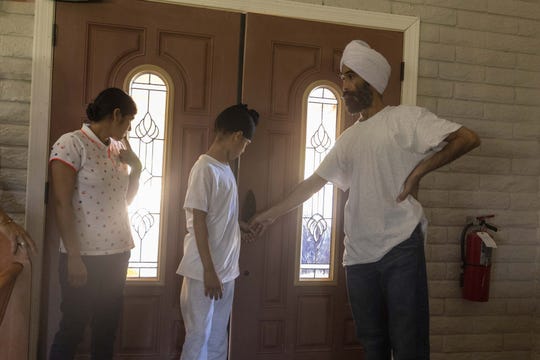
Sikh family Parmijit Kaur (left), husband Surjit Singh and their 12 year-old-son Sukhvir Singh arrive at Iglesia Cristiana El Buen Pastor Church in Mesa on Thursday, Oct. 24, 2019. (Photo: Nick Oza/The Republic)
Experts point out that refugees and asylum-seekers are often portrayed as destitute and impoverished, a misconception that likely was reinforced by the wave of mostly poor Central American families who poured across the border earlier this year in unprecedented numbers and received so much media attention.
In reality, people forced to leave their home countries due to persecution come from all walks of life, economic backgrounds and education levels, experts say.
The sudden arrival of families from India, for example, could reflect rising persecution against religious minorities, including Sikhs, Muslims and Christians, in that country under the government of Prime Minister Narendra Modi, a Hindu nationalist.
"Indians have been seeking asylum for years now," though in the past most were adult men, not families, said Randy Capps, director of research for U.S. programs at the nonpartisan Migration Policy Institute.
"Many of them are religious minorities, Sikhs in particular," Capps said. "They are fleeing religious persecution in many cases so their motive on the surface doesnít appear to be economic the way it appears partially for many of the poorer people coming from Mexico and Central America."

Sukhvir Singh, age 12 and part of a Sikh family from India, arrives with his parents at Iglesia Cristiana El Buen Pastor Church in Mesa on Thursday, Oct. 24, 2019. (Photo: Nick Oza/The Republic)
The arrival of Chinese and Russian speaking families asking for asylum also is not surprising, said Daniel Balson, advocacy director for Europe and Central Asia at Amnesty International USA.
"There is any number of reasons for why individuals from across Eastern Europe and Asia would be interested in the United States," Balson said. "Obviously, the government of the Russian Federation is remarkably repressive. This is especially true if you are active politically, or are actively speaking out against the policies of the (Vladimir) Putin government."
Harder to explain is the growing numbers of non-Spanish speaking families at the U.S.-Mexico border. Non-Spanish speaking migrants in the past almost always tended to be young adult men.
Balson believes the Trump administration's immigration policies are driving more non-Spanish speaking migrants, including families, to seek asylum at the southern border, either by crossing illegally or at ports of entry, rather than flying directly to the U.S. with visas.
"The Trump administration has shut down virtually all of the common paths for individuals fleeing persecution who are interested in seeking asylum," Balson said. "This is really true around the world. What this has resulted in is individuals who are fleeing persecution who have credible claims for asylum are looking for other alternative paths to make those claims. And the southern route is an immigration route that is common."
Balson cited examples such as the Trump administration's slashing of refugee admissions into the U.S. and the so-called Muslim ban, which under a version upheld by the Supreme Court in 2018 blocks travel to the U.S. from six predominantly Muslim countries as well as North Koreans and certain Venezuelan government officials.
Some of the migrant families arriving from other continents could be paying smuggling organizations to reach the U.S., he said.
"What we have seen in Europe is what we have seen in the United States," Balson said, "that shutting down safe, effective ways to secure asylum functions as a subsidy for militiamen, human-traffickers, war lords of all different shapes and stripes."
Balson pointed out that migrant families from other continents who choose to travel through Mexico face the same deadly risks as those from Spanish-speaking countries.
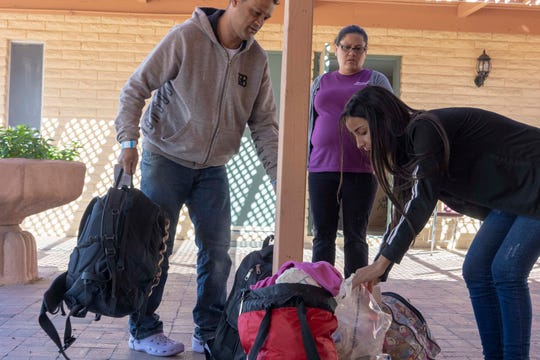
Volunteer members help Adriano Moraes da Silva, 43, and his daughter Rikelly Stephany Rodrigues Moraes, 16, get food and clothing after the asylum seekers from Brazil were released by ICE at Iglesia Cristiana El Buen Pastor Church in Mesa, Arizona. (Photo: Nick Oza/The Republic)
On June 12, the body of a 7-year-old girl from India was found in a remote desert area in the Organ Pipe Cactus National Monument in southern Arizona where hundreds of migrants have perished in recent years.
The girl had crossed the border illegally with a group of migrants from India, the Border Patrol said.
The Indian girl died less than two weeks before the bodies of a father from El Salvador and his 23-month-old daughter were found on the banks of the Rio Grande in Matamoros, Mexico. The pair drowned trying to reach Brownsville, Texas by wading across the river into the U.S.
On Nov. 14, a Border Patrol agent shot and wounded a migrant from Russia suspected of trying to cross the border illegally near Lukeville in the southwestern corner of Arizona The agent fired his weapon while trying to arrest the migrant and an altercation ensued, the Border Patrol said. It was not clear if the Russian migrant was traveling alone or with a family.
"The bottom line is that nobody wants to leave their home to travel to a foreign land where they donít speak the language, trek across dangerous terrain only to face hostile border guards," Balson said. "When people do this, especially with their families, with their children, it simply is reflective of the fact that their conditions at home have become so unstable, so dangerous so terrifying that this perilous journey is the only possible alternative that they can envision."
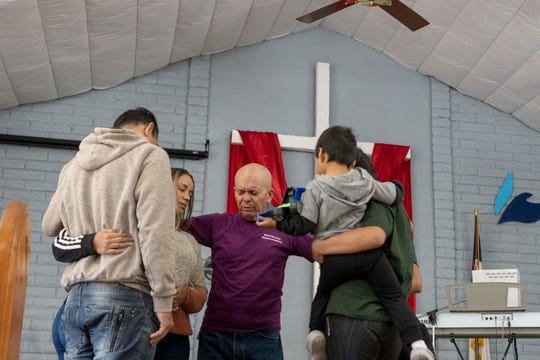
Asylum seekers Claudineia Ferreira Rodrigues Moraes, 40, and her husband Adriano moraes da Silva, 43, from Brazil (left) and Sandra Estefania Lema Guaraca, 20, with her 3-year-old son Derick from Ecuador, prays with Co-pastor Hector Ramirez after they were released by ICE at Iglesia Cristiana El Buen Pastor Church in Mesa, Arizona. (Photo: Nick Oza/The Republic)
The rise in migrant families from other continents arriving at local shelters may show that while the Trump administration has effectively closed the door on migrant families from Central America, it remains open for others, said Capps at the Migration Policy Institute.
"Over time, people from all over the world are learning that the U.S. system has a hole in it when it comes to families seeking asylum," Capps said.
The Trump administration has essentially "plugged" that hole for Central Americans through policies that now require Central Americans to wait in Mexico for asylum hearings in the U.S.
The U.S. has pressured Mexico to stop Central American migrants from reaching the U.S.
Additionally, the U.S. has recently signed agreements with Guatemala, El Salvador and Honduras that require asylum-seekers who pass through to apply in those countries first.
"But it hasnít been plugged for the extra-continentals, for the non-Spanish speakers," Capps said.
Why are families coming to the United States from China, India?
On Tuesday, Oct. 29, immigration authorities dropped off four families at Iglesia Cristiana Buen Pastor, a small Hispanic church in Mesa.
Three of the families were not out of the ordinary. They included a mother and her 2-year-old son from Chiapas, Mexico, a couple and their 6-year-old daughter from Morelos, Mexico, and a couple and their 4-year-old son from Brazil.
But the fourth family, a mother and her 17-year-old son stood out. They came from China, and spoke only a few words of English.
Zhu Yanying, the 41-year-old mother, her hair cut short, wore an a orange puffy jacket. She had a GPS monitoring device placed on one ankle by immigration authorities before her release to track her whereabouts.
She told a Chinese-speaking reporter that she and her son, Zou Ling Jie, were fleeing religious persecution in Fujian, a province in China.
She said she decided to bring her son to the U.S. to ask for asylum after she was jailed for 14 days by the police because of her religious views.
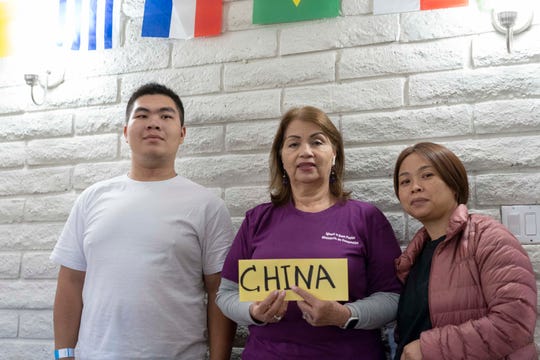
Volunteer members help asylum seekers Zhu Yanying, 41, and her son Zou Ling Jie, 17, from China. They were released by ICE at Iglesia Cristiana El Buen Pastor Church in Mesa, Arizona. Co-pastor Cecilia Ramirez, arranged for food, shelter and their final destination. (Photo: Nick Oza/The Republic)
She said she and her son had plane tickets for a 3:30 p.m. flight from Phoenix to New York City, where a relative lives. The tickets were bought for them by relatives in New York.
After eating breakfast at tables volunteers had set up for the families outside in a patio, Yanying and her son went into the church kitchen to figure out how they were going to get to the airport.
To communicate, volunteers spoke into their phones in English and Spanish, using an app to translate their words into Chinese, and then back again into English or Spanish.
"Sarah, one of our volunteers, is going to take you to the airport at 1:30 because you need to be at the airport two hours before your flight," Renata Garza Irving, one of the church volunteers, told them through the phone app.
Two weeks earlier, immigration authorities released a family from India at the same church: Surjit Singh, 39, his wife, Parmit Kaur, 35, and their 11-year-old son, Sukhvir.
Singh and his son wore turbans on their heads, which identified them as Sikhs, a religious minority in India.
Singh told a Punjabi-speaking reporter that his family came from Punjab, where the majority of the population are Sikhs.
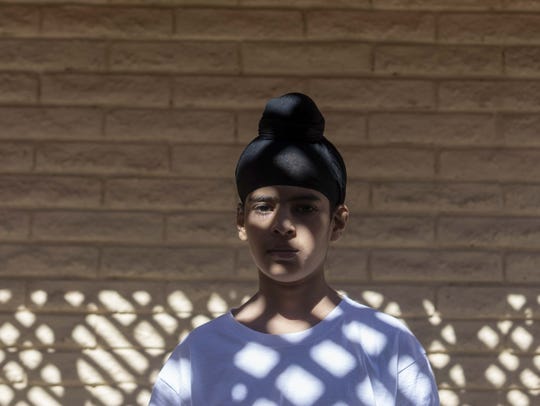
Sukhvir Singh, age 12 and part of a Sikh family from India, arrives with his parents at Iglesia Cristiana El Buen Pastor Church in Mesa. (Photo: Nick Oza/The Republic)
He said it took the family two months to reach the U.S. They first flew from India to Dubai, then to Paris and then to Ecuador. From Ecuador, Singh said the family flew to Cancun, a resort city in southern Mexico, and then traveled by bus to the southern border of the U.S.
Singh said the family was on their way to the Los Angeles area, where Singh said a nephew lived. Southern California is home to one of the largest Sikh Indian populations in the U.S.
When the reporter asked Singh how much the trip had cost them, he turned and walked away. Singh refused to answer any more questions.
The Indian family did not stay at the church long. They ate a vegetarian lunch served by volunteers, took showers and picked out a few items of clothing from a room with racks full of donated items, then hopped in a cab to drive them from Phoenix to California.
Before the family left, Singh told one of the church volunteers, "You are so generous, I will never forget your help."
https://www.azcentral.com/story/news...ts/4073883002/
NO AMNESTY
Don't reward the criminal actions of millions of illegal aliens by giving them citizenship.
Sign in and post comments here.
Please support our fight against illegal immigration by joining ALIPAC's email alerts here https://eepurl.com/cktGTn
-
11-19-2019, 06:00 PM #2
RELEASE THEM BACK HOME ON THEIR SOIL.
THIS IS OUTRAGES!!!ILLEGAL ALIENS HAVE "BROKEN" OUR IMMIGRATION SYSTEM
DO NOT REWARD THEM - DEPORT THEM ALL
-
11-19-2019, 07:39 PM #3NO AMNESTY
Don't reward the criminal actions of millions of illegal aliens by giving them citizenship.
Sign in and post comments here.
Please support our fight against illegal immigration by joining ALIPAC's email alerts here https://eepurl.com/cktGTn
Similar Threads
-
More families crossing U.S. border illegally at San Diego
By JohnDoe2 in forum illegal immigration News Stories & ReportsReplies: 9Last Post: 12-11-2018, 08:18 PM -
India nationals illegally crossing the US-Mexico border in record numbers
By JohnDoe2 in forum illegal immigration News Stories & ReportsReplies: 11Last Post: 09-12-2018, 09:49 PM -
India nationals illegally crossing the US-Mexico border in record numbers, pay smuggl
By 6 Million Dollar Man in forum illegal immigration News Stories & ReportsReplies: 3Last Post: 08-12-2018, 05:49 PM -
Immigrant families still coming, but in smaller numbers
By JohnDoe2 in forum illegal immigration News Stories & ReportsReplies: 0Last Post: 01-18-2015, 01:07 PM -
More Illegal Immigrants From India Crossing Border
By dsprtt in forum General DiscussionReplies: 7Last Post: 07-21-2011, 10:59 AM


 LinkBack URL
LinkBack URL About LinkBacks
About LinkBacks




 Reply With Quote
Reply With Quote


Listen to William Gheen on Rense Apr 24, 2024 talking Invasion...
04-25-2024, 02:03 PM in ALIPAC In The News